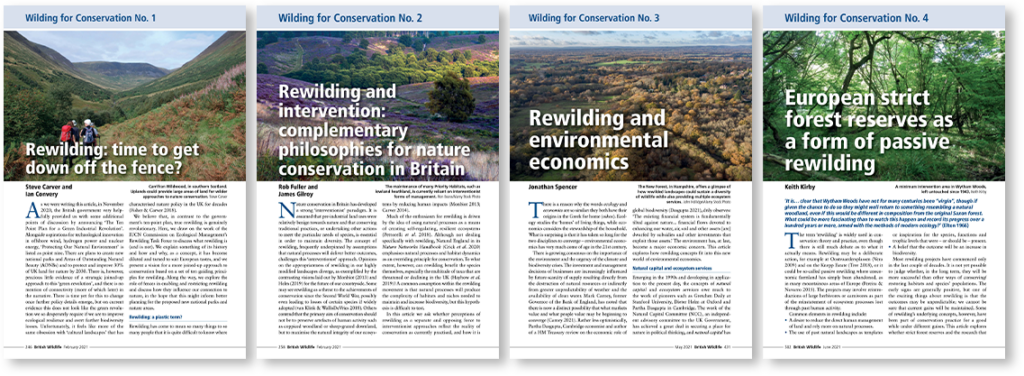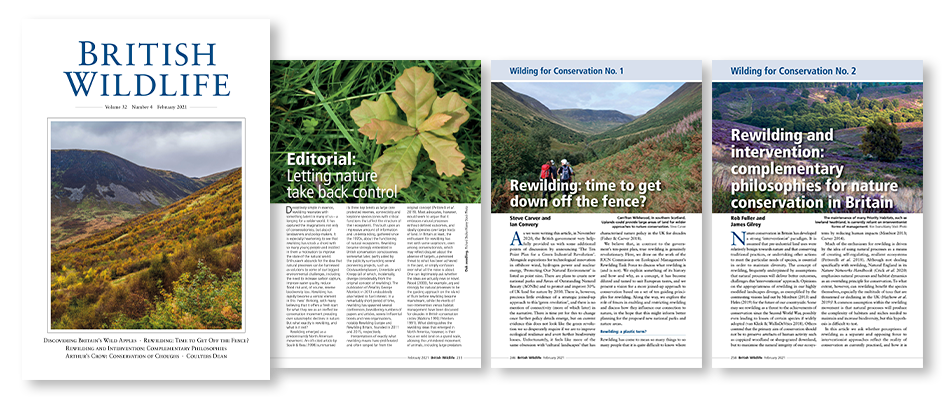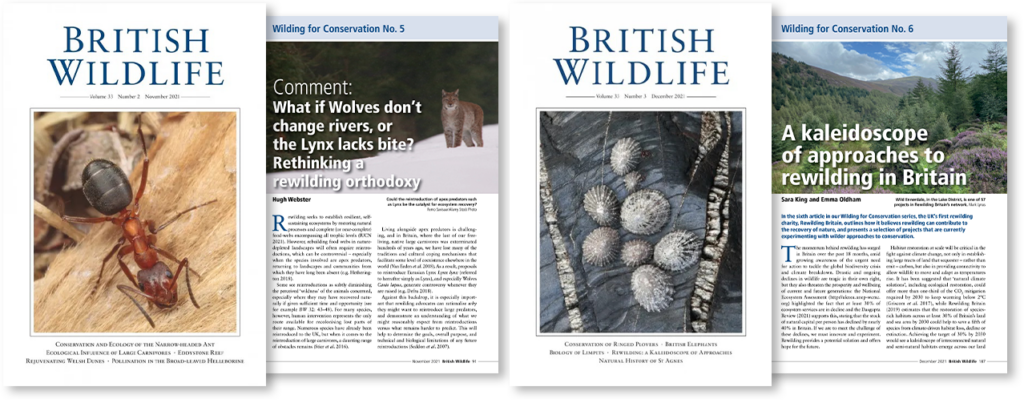Wilding for Conservation
In a short space of time rewilding has grown to become a powerful force in conservation. The idea of giving nature the freedom and space to forge its own path is not just inspiring, but also raises deeper questions about our relationship with the natural world and how best to serve wildlife and ecosystems through a period of enormous challenge for conservation. Accompanying this new interest, though, is uncertainty – over where and how rewilding should be applied, how it fits with traditional approaches to habitat management, what it can offer for the numerous species struggling to survive in the British countryside, and even what rewilding is.

With momentum only set to build, discussion of the direction of travel, and opportunities and challenges for rewilding remains as important as ever. The ‘Wilding for Conservation’ series, launched in British Wildlife at the start of 2021, aims to provide a forum for that discussion, and to share a range of perspectives on the role of rewilding in the future recovery of our fauna and flora. To date there have been 12 pieces published in the series, with more set to appear through the remainder of 2023 and beyond. Here we provide a compilation of all articles published so far – digital subscribers can explore the series by following the links below.
Editorial: Letting nature take back control
By Rob Fuller and Guy Freeman
32.4 February 2021
Series Editor Rob Fuller and BW Editor Guy Freeman launch Wilding for Conservation with an editorial that looks back at the magazine’s earlier contributions to the rewilding debate and sets out the aims for the series. An appendix of older articles of relevance to rewilding can be found here.
1. Rewilding: time to get down off the fence?
By Steve Carver and Ian Convery
32.4 February 2021
A walk through the history and evolving definitions of rewilding and a plea for a wilder and more ambitious future for conservation in Britain – with fewer fences.
2. Rewilding and intervention: complementary philosophies for nature conservation in Britain
By Rob Fuller and James Gilroy
32.4 February 2021
An exploration of how rewilding and intervention might be deployed in combination to produce the best possible results for wildlife in Britain.

3. Rewilding and environmental economics
By Jonathan Spencer
32.4 February 2021
An exploration of how rewilding and intervention might be deployed in combination to produce the best possible results for wildlife in Britain.
4. European strict forest reserves as a form of passive rewilding
By Keith Kirby
32.7 June 2021
What lessons can British conservation take from the ancient and unmanaged Strict Forest Reserves of Continental Europe?
5. Comment: What if Wolves don’t change rivers, or the Lynx lacks bite? Rethinking a rewilding orthodoxy
By Hugh Webster
33.2 November 2021
Reintroduction of apex carnivores is often touted as a silver-bullet solution to various environmental problems, but the evidence for ecosystem-level impacts of large predators is not quite so clear cut.
6. A kaleidoscope of approaches to rewilding in Britain
By Sara King and Emma Oldham
33.3 December 2021
The UK’s first rewilding charity, Rewilding Britain, presents a selection of case studies of projects currently experimenting with wilder approaches to conservation in Britain.
7. Comment: Rewilding: a landscape-history perspective
By Tom Williamson
33.6 May 2022
The practical and philosophical limitations of rewilding and the conundrum it poses for conservation of the distinct assemblages of cultural, managed landscapes.

8. Can wildwoods help us avert climate disaster?
By Ellie Crane
33.7 June 2022
Could wilder approaches to woodland management and creation of new wildwoods play a role in the battle against climate change?
9. Comment: A long-term perspective on rewilding woodland
By George Peterken
33.8 August 2022
Observations from Britain’s best known ‘wild’ woodland, Lady Park Wood, and the significance of these for new woodland rewilding projects.
10. The implications of Orthoptera of grazing in arable wilding schemes
By Tim Gardiner and Dorothy Casey
34.1 October 2022
An account of the impressive response in abundance of grasshoppers and crickets to passive rewilding of former arable farmland.
11. Wild oakwoods: can they exist in lowland England?
By Aljos Farjon
34.3 December 2022
Given the apparent struggles of oaks to regenerate in competition with other trees, is there a future for wild oakwoods in southern Britain?
12. Is rewilding relevant to contemporary forest policy?
By Norman Dandy
34.4 February 2023
Commercial forestry may appear to be the antithesis of rewilding, but overlap, where it exists, must be explored and developed given the dominance of plantations in the countryside.
13. The New Forest: shaped by the past and a model for the future
By Jonathan Spencer
34.6 May 2023
What can new rewilding projects learn from the ancient and diverse landscape of the New Forest?
14. Is conservation ready to go wild? Perspectives from the eNGOs
By Patrick Barkham
34.7 June 2023
Rewilding might be a distraction or a panacea depending on who you ask, but to what extent is its popularity influencing the thinking of the conservation NGOs?
15. The return of the wildwood
By Adrian C. Newton
35.1 October 2023
Does the creation of wild woodland receive its due share of attention in current rewilding projects?

16. In natural processes we trust: rewilding and freshwater-wetland restoration
By Carl Sayer, Oliver van Biervliet, Reagan Pearce and Theodore Mills
35.4 February 2024
With rivers and lakes facing a cocktail of threats, but returning them to their wilder roots could offer hope for their revival.
17. Rewilding in the Scottish Highlands – natural regeneration of Caledonian pinewoods versus planting
By Ron Summers
35.5 April 2024
An argument for a greater role for natural regeneration – and a lesser focus on planting – in efforts to expand woodland in the Highlands.
18. Pulse grazing in rewilding projects and the effects on invertebrate diversity
By Graeme Lyons, Mark Monk-Terry and Malcolm Ausden
35.7 June 2024
An example of where pulse grazing has been used to good effect to increase habitat variation at Butcherlands, Sussex. This article offers perspectives on how this approach compares to other grazing regimes commonly used in rewilding projects.
19. The wilding debate and the coastal zone: never the twain shall meet?
By Graham Weaver
35.8 August 2024
Can and, if possible, how can rewilding philosophies can be applied in coastal landscapes?
20. Rewilding and the woodland ground flora
By George F. Peterken and Keith J. Kirby
36.1 October 2024
An outline of what we can expect from the field layer of new ‘rewilded’ woods based on lessons from long-term studies on the development of new woodlands.
21. The urban wild: a perspective from Northern England
By Ian D. Rotherham
36.2 November 2024
The implementation of conservation projects in remote ‘wild’ areas is insufficient as a sole response to contemporary environmental challenges. An argument for the importance of ‘wilding’ urban areas.
22. A spectrum-based approach to rewilding: can it improve perceptions of rewilding in farming communities?
By Benedict Dempsey
36.3 December 2024
Could a ‘spectrum based’ reframing help to depolarise perceptions of rewilding, particularly within farming communities?
23. Comment: British bison: nature and climate in the UK
By Evan Bowen-Jones
36.4 February 2025
An argument for the pragmatic utilisation of ecosystem engineers as the only viable future for conservation in a Britain in a changing climate.
24. Rewilding in a changing climate- risks and opportunities
By James Pearce-Higgins
36.4 February 2025
Do conservation efforts to mitigate biodiversity loss do enough to incorporate a pragmatic approach to the reality of our changing climate?
25. Planting to assist recovery
By Max Coleman
36.5 April 2025
A mediation on the perceived on the perceived incompatibility between planting and the naturalist’s notion of ‘wildness’. When is planting appropriate for conservation.
26. Rewilding and restoring: two distinct yet complimentary approaches to nature recovery
By Nathalie Pettorelli and James M. Bullock
36.5 May 2025
What is the difference between rewilding an ecosystem and restoring it? And when should we consider one or the other?
